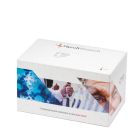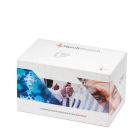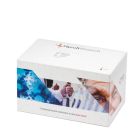TCC ELISA, human, kit – 1 x 96 det. - HK328-01
Quantity
1 x 96 det.
Catalog #
HK328-01
756,00 €
Introduction to Terminal Complement Complex (TCC)
The Terminal Complement Complex (TCC), also recognized as sC5b-9, serves as a pivotal biomarker in assessing the immune response within the human body. This complex, integral to research endeavors, is central to the body's innate defense mechanism.
Activation Pathways and TCC ELISA Significance
Central to the complement system are three distinct activation pathways, all converging at the formation of a C5 convertase. It is the cleavage of C5 by these convertases that marks the commencement of the terminal or lytic pathway, a crucial stage in immune response. TCC ELISA emerges as a critical tool in this context, offering precise measurement and monitoring of these activities.
The Terminal Pathway Mechanism
Contrasting the activation pathways that necessitate enzymatic cleavage for activation, the terminal pathway operates predominantly through conformational changes induced upon binding. This intricate mechanism initiates with the binding of C6, which in turn facilitates the binding of C7, consequently altering the complex's conformation. Subsequent binding of C8 and the association of a variable number of C9 molecules with the C5b678 complex results in the formation of the Terminal Complement Complex (TCC) or Membrane Attack Complex (MAC).
The Role of Neoantigens in TCC
The formation of TCC in its membrane-bound form is a harbinger for cell lysis or the activation of various cellular metabolic pathways. These pathways are pivotal as they culminate in the synthesis and subsequent release of inflammatory mediators. A distinct feature of the TCC is the inclusion of neoantigens, not found in its separate native parts. These neoantigens appear in both the membrane-bound (MAC) and fluid-phase (SC5b-9) forms of TCC. This adds complexity and importance to TCC's role in the immune response.
TCC ELISA in Research
TCC ELISA is crucial due to its detectability in normal human plasma, where it's usually under 1 AU/ml. It significantly increases in patients with active immune responses. This measurable factor proves TCC ELISA's value in research. It enables detailed insights and continuous monitoring of the immune system's activity.
How to analyze complement
For accurate complement analysis, it is important that not only the correct technique is used but also that pre-analytical sample handling is performed in an appropriate manner to avoid erroneous results.
Go to optimal guidelines
The Terminal Complement Complex (TCC), also recognized as sC5b-9, serves as a pivotal biomarker in assessing the immune response within the human body. This complex, integral to research endeavors, is central to the body's innate defense mechanism.
Activation Pathways and TCC ELISA Significance
Central to the complement system are three distinct activation pathways, all converging at the formation of a C5 convertase. It is the cleavage of C5 by these convertases that marks the commencement of the terminal or lytic pathway, a crucial stage in immune response. TCC ELISA emerges as a critical tool in this context, offering precise measurement and monitoring of these activities.
The Terminal Pathway Mechanism
Contrasting the activation pathways that necessitate enzymatic cleavage for activation, the terminal pathway operates predominantly through conformational changes induced upon binding. This intricate mechanism initiates with the binding of C6, which in turn facilitates the binding of C7, consequently altering the complex's conformation. Subsequent binding of C8 and the association of a variable number of C9 molecules with the C5b678 complex results in the formation of the Terminal Complement Complex (TCC) or Membrane Attack Complex (MAC).
The Role of Neoantigens in TCC
The formation of TCC in its membrane-bound form is a harbinger for cell lysis or the activation of various cellular metabolic pathways. These pathways are pivotal as they culminate in the synthesis and subsequent release of inflammatory mediators. A distinct feature of the TCC is the inclusion of neoantigens, not found in its separate native parts. These neoantigens appear in both the membrane-bound (MAC) and fluid-phase (SC5b-9) forms of TCC. This adds complexity and importance to TCC's role in the immune response.
TCC ELISA in Research
TCC ELISA is crucial due to its detectability in normal human plasma, where it's usually under 1 AU/ml. It significantly increases in patients with active immune responses. This measurable factor proves TCC ELISA's value in research. It enables detailed insights and continuous monitoring of the immune system's activity.
How to analyze complement
For accurate complement analysis, it is important that not only the correct technique is used but also that pre-analytical sample handling is performed in an appropriate manner to avoid erroneous results.
Go to optimal guidelines
| Datasheet URL | https://www.hycultbiotech.com/wp-content/uploads/2022/06/HK328-1223.pdf |
|---|---|
| Quantity | 1x96det. |
| Quantity | 1 x 96 det. |
| Standard range | 8.2 to 2000 mAU/ml |
| Detection level | 8.2 mAU/ml |
| Working volume | 100 µl/well |
| Species | human |
| Cross reactivity | Cynomolgus monkey - Yes, Horse - No, Mouse - No, Pig - Yes, Rabbit - Yes, Rat - No |
| Application | The human terminal complement complex (TCC) ELISA kit is to be used for the in vitro quantitative determination of human TCC in plasma, urine, cerebrospinal fluid, joint fluid and cell culture supernatant samples. |
| Principle | The human TCC ELISA is a ready-to-use solid-phase enzyme-linked immunosorbent assay based on the sandwich principle with a working time of 3½ hours. The efficient format of 2 plates with twelve disposable 8-well strips allows free choice of batch size for the assay. Samples and standards are captured by a solid bound specific antibody. Biotinylated tracer antibody will bind to captured TCC. Streptavidin-peroxidase conjugate will bind to the biotinylated tracer antibody. Streptavidin-peroxidase conjugate will react with the substrate, tetramethylbenzidine (TMB). The enzyme reaction is stopped by the addition of oxalic acid. The absorbance at 450 nm is measured with a spectrophotometer. A standard curve is obtained by plotting the absorbance (linear) versus the corresponding concentrations of the TCC standards (log). The TCC concentration of samples, which are run concurrently with the standards, can be determined from the standard curve. |
| Storage and stability | Product should be stored at 4 °C. Under recommended storage conditions, product is stable for at least six months. |
| Precautions | For research use only. Not for use in or on humans or animals or for diagnostics. It is the responsibility of the user to comply with all local/state and Federal rules in the use of this product. Hycult Biotech is not responsible for any patent infringements that might result with the use of or derivation of this product. |
| References | 1. Mollnes, T et al; Quantification of the terminal complement complex in human plasma by an enzyme-linked immunosorbent assay based on monoclonal antibodies against a neoantigen of the complex. Scand J Immunol 1985, 22: 197 2. Mollnes, T et al; Monoclonal antibodies recognizing a neoantigen of poly(C9) detect the human terminal complement complex in tissue and plasma. Scand J Immunol 1985, 22: 183 3. Fiane, M et al; Mechanism of complement activation and its role in the inflammatory response after thoracoabdominal aortic aneurysm repair. Circulation 2003, 108: 849 4. Savage, D et al; Complement abnormalities in acquired lipodystrophy revisited. J Clin Endocrinol Metab 2009, 94: 10 5. Lundahl, J et al; IL-8 from local subcutaneous wounds regulates CD11b activation. Basic Immunology 2011 6. Stahl, A et al; Complement activation on platelet-leukocyte complexes and microparticles in enterohemorrhagic Escherichia coli–induced hemolytic uremic syndrome. Blood 2011, 117 |
| Disease | Infectious diseases, Nephrology |
| Application assays: | The human terminal complement complex (TCC) ELISA kit is to be used for the in vitro quantitative determination of human TCC in plasma, urine, cerebrospinal fluid, joint fluid and cell culture supernatant samples. |
|---|---|
| Principle: | The human TCC ELISA is a ready-to-use solid-phase enzyme-linked immunosorbent assay based on the sandwich principle with a working time of 3½ hours. The efficient format of 2 plates with twelve disposable 8-well strips allows free choice of batch size for the assay. Samples and standards are captured by a solid bound specific antibody. Biotinylated tracer antibody will bind to captured TCC. Streptavidin-peroxidase conjugate will bind to the biotinylated tracer antibody. Streptavidin-peroxidase conjugate will react with the substrate, tetramethylbenzidine (TMB). The enzyme reaction is stopped by the addition of oxalic acid. The absorbance at 450 nm is measured with a spectrophotometer. A standard curve is obtained by plotting the absorbance (linear) versus the corresponding concentrations of the TCC standards (log). The TCC concentration of samples, which are run concurrently with the standards, can be determined from the standard curve. |
| Perfomance: | The linearity of the assay was determined by serially diluting a sample containing 250 mAU/ml human TCC. The diluted samples were measured in the assay. The line obtained a slope of 0.967 and a correlation coefficient of 0.999. |
| Recovery: | Normal human blood samples (plasma), containing baseline levels of human TCC, were spiked with human TCC in concentrations of 2500 and 250 mAU/ml. Samples with and without TCC were incubated for 1 hour at 4° C. Samples were measured by ELISA. Values for TCC ranged between 153% and 128% (mean 140%). |






